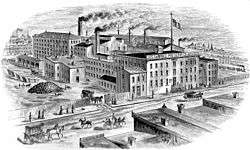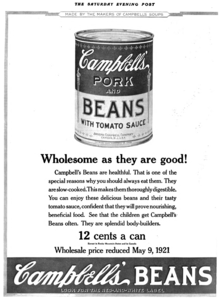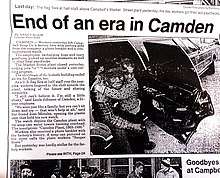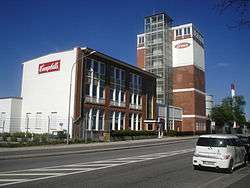Campbell Soup Company
The Campbell Soup Company, also known as just Campbell's, is an American processed food and snack company. As the name implies, the company is most closely associated with its flagship canned soup products, however it has through mergers and acquisitions grown to become one of the largest processed food companies in the U.S., with a wide variety of products under its flagship Campbell's brand as well as such well-known brands as Pepperidge Farm, Snyder's of Hanover, V8, and Swanson. Under these brands and many others, Campbell's produces not only soups and broths, but other canned meals such as SpaghettiOs, baked goods such as cookies and crackers, beverages, and salty snacks such as pretzels and potato chips. It is headquartered in Camden, New Jersey.[3]
 | |
 Entrance to Campbell's headquarters in Camden | |
| Public | |
| Traded as | NYSE: CPB S&P 500 Component |
| ISIN | US1344291091 |
| Industry | Food processing |
| Founded | 1869 |
| Founder | Joseph A. Campbell |
| Headquarters | Camden, New Jersey, U.S. |
Key people | Mark Clouse (CEO) |
| Products | Campbell's Pepperidge Farm Pace V8 |
| Revenue | |
| Total assets | |
| Total equity | |
Number of employees | 18,000[2] (2017) |
| Subsidiaries | Pepperidge Farm Pace Foods Snyder's-Lance |
| Website | www |


The classic red-and-white can design used by many Campbell's branded products has become an American icon, and its use in pop art was typified by Andy Warhol's series of Campbell's Soup Cans prints.
History
The company was started in 1869 by Joseph A. Campbell, a fruit merchant from Bridgeton, New Jersey, and Abraham Anderson, an icebox manufacturer from South Jersey.[4] They produced canned tomatoes, vegetables, jellies, soups, condiments, and minced meats.
In 1876, Anderson left the partnership and the company became the "Joseph A. Campbell Preserve Company".[5] Anderson's son, Campbell Speelman, split paths with his father and continued to work at Campbell's as a creative director, originally designing the Campbell's Soup Cans.[6]
Campbell reorganized into "Joseph Campbell & Co." in 1896. In 1897, John T. Dorrance, a nephew of the general manager Arthur Dorrance, began working for the company at a wage of $7.50 a week.[5][7] Dorrance, a chemist with degrees from MIT and Göttingen University, Germany, developed a commercially viable method for condensing soup by halving the quantity of its heaviest ingredient: water.[4] He went on to become president of the company from 1914 to 1930, eventually buying out the Campbell family.[8]
In 1898, Herberton Williams, a Campbell's executive, convinced the company to adopt a carnelian red and bright white color scheme, because he was taken by the crisp carnelian red color of the Cornell University football team's uniforms.[9] To this day, the layout of the can, with its red and white design and the metallic bronze medal seal from the 1900 Paris Exhibition, has changed very little, with the exception of the French phrase on the top of the bronze seal that said "Exposition-Universelle-Internationale" which was changed to the English name of the exhibition as "Paris International Exposition".
Campbell Soup became one of the largest food companies in the world under the leadership of William Beverly Murphy. He was elected executive vice president of Campbell Soup in 1949 and was President and CEO from 1953 to 1972. While at Campbell's Soup Company, he took the corporation public and increased its brand portfolio to include Pepperidge Farm's breads, cookies, and crackers, Franco-American's gravies and pastas, V8 vegetable juices, Swanson broths, and Godiva's chocolates. David Johnson was President and CEO from 1990 until 1997.
Campbell Soup has invested heavily in advertising since its inception, and many of its promotional campaigns have proven value in the Americana collectible advertising market. Perhaps best known are the "Campbell's Kids" designed by illustrator Grace Drayton.[4] Ronald Reagan was a spokesman for V8 when Campbell's acquired the brand in 1948.[10]
In addition to collectible advertising, the company has had notable commercial sponsorships. Among these was Orson Welles's The Campbell Playhouse, which had previously been The Mercury Theatre on the Air. After the program's adaptation of The War of the Worlds became a sensation for accidentally starting a mass panic due to its realism, Campbell's took over as sponsor of the radio theater program in December 1938.
The shutdown of Campbell's Camden, New Jersey, plant No. 1 was announced in 1989 and production stopped on the night of March 1, 1991. The following day, the plant was officially closed. It was demolished on November 1, 1991. Plants in Pocomoke City (Maryland), Crisfield (Maryland), and Smyrna (Tennessee) also shut down.[11]
Plant No. 2, originally a tomato-processing plant, shut down in 1980. It was responsible for about 35% of all Campbell's products in the 1950s. Products included pork and beans, tomato juice, V-8 vegetable juice, Franco-American spaghetti, macaroni and cheese, and soups (notably: beans and bacon, cream of mushroom, cream of celery, and cream of asparagus).[12]

.jpg)
A total of 2,800 jobs were lost, 940–1,000 of those jobs from the Camden plant. Campbell's agreed to give workers one week's payment for each year of employment as well as paying in full for six months of medical benefits, and paying half the cost for another six months. Salaried workers received one week's pay for each year of employment.[13] Production was moved to plants in Napoleon (Ohio), Paris (Texas), and Maxton (North Carolina).[14] [15]
In the UK and Ireland, Campbell Soup was rebranded as Batchelors Condensed Soup (UK) and Erin (Ireland) in March 2008, when the license to use the brand name expired. Premier Foods, St. Albans, Hertfordshire bought the Campbell Soup Company in the UK and Ireland, for £450 million ($830 million) in 2006, but was licensed to use the brand only until 2008. Under this agreement, the US-based Campbell Soup Company continued to produce Campbell's Condensed Soup but could not sell the product in the UK for a further five years.[16]
Campbell's continues to be a major part of Camden, regularly participating in charity events[17][18] in the community. In 2009, Campbell's completed the building of a new and expanded headquarters[19] in the city.
In January 2010, Campbell's Canadian subsidiary began selling a line of soups that are certified by the Islamic Society of North America as being halal (prepared in accordance with Islamic law). Although Campbell does not have any plans to sell its halal soups in the United States, the move has drawn criticism from anti-Muslim critics in the United States. Several bloggers called for a boycott of the company, but Campbell's spokesman John Faulkner stated at the time that the company did not notice any effect on its sales as a result.[20]
In November 2007, Campbell's Soup sold Godiva to Yildiz Holding.
In July 2011, Campbell's Soup decided to once again sell its product in the UK after being absent since 2008. Symingtons began manufacturing the brand under license. The new line-up comprised twelve cup soups, five simmer soups designed to be cooked in a pot of water, four savoury rice lines, and four savory pasta and sauce packets. The new range were not sold in cans, but instead in packets and boxes. Later in 2011, the canned varieties also returned to supermarket shelves with refreshed labels and new lines.[21]
In 2012, Campbell announced plans to buy Bolthouse Farms, a maker of juices, salad dressings and baby carrots, for $1.55 billion. Analysts saw this as an attempt to reach younger, more affluent consumers.[22]
From 2012, Campbell Soup has been focused on updating their image and digital marketing to increase visibility among younger generations. They hired Umang Shah to lead global social and digital marketing. He led record social engagement campaigns including #DeclareRecess and #BIGFiveO.[23]
In June 2013, Campbell acquired the Danish multinational baked goods company Kelsen Group for an undisclosed amount.[24] Kelsen has an 85-country distribution network and is seen as providing Campbell with opportunities for international expansion, particularly into China and other Asian markets.[24]
In June 2015, Campbell Soup acquired salsa maker Garden Fresh Gourmet for $231 million as it looked to expand into the fresh and organic packaged foods business.[25]
In December 2017, Campbell's completed the acquisition[26] of Pacific Foods of Oregon, LLC[27] for $700 million and announced the agreement to acquire the snack company Snyder's-Lance for $4.87 billion in cash.[28] The latter deal is the largest in the company's history.[29]
The company announced in January 2018 that their only Canadian factory, in Toronto, would close. Production would shift to three existing facilities within the U.S. It was reported that the expected loss of jobs, as a result of the closing, would be 380.[30]
Denise Morrison served as the company's president and CEO from 2011 through 2018.[31]
On December 21, 2018, former Pinnacle Foods CEO Mark Clouse was named the next Campbell's CEO, effective January 22, 2019.[32]
In July 2019, Campbell's agreed to sell its stake in the Kelsen Group for $300 million to a subsidiary of Ferrero SpA. The transfer will be completed sometime early 2020.[33]
Pop art
In 1962, artist Andy Warhol took the familiar look of the Campbell's soup can and integrated it into a series of pop art silkscreens, a theme he would return to off and on through the 1960s and 1970s. The first batch in 1962 were a series of 32 canvases. At first, the cans were accurate representations of actual Campbell's cans, but as his series progressed, they became more surrealistic, with Warhol experimenting with negative-reversed color schemes and other varied techniques (many of these which would be used on other Warhol paintings of the period, such as his celebrity silkscreens of the 1960s). The silkscreens themselves have become iconic pieces of pop art, with one in particular, Small Torn Campbell Soup Can (Pepper Pot) (1962), commanding a price of $11.8 million at auction in 2006.
In 2004, Campbell's themselves recognized Warhol's art by releasing in the eastern United States a limited-edition series of cans that were inspired by the coloring and silkscreen effects of Warhol's pieces. This marked one of the few times in the company's history that they would change the trade dress for their main canned-soup line in any substantial manner. In 2012, the Warhol-inspired cans returned to shelves, in an exclusive retail partnership with Target.
Slogans
- Mmm Mmm Good (1935–present; their predominantly used slogan)[34]
- Give Me The Campbell Life (1969–75)
- Soup Is Good Food (1975–c.1982)
- Never underestimate the power of soup! (1990s)
- Possibilities (2005–2008)
- So Many Many Reasons It's So Mmm Mmm Good (2009–2010)
- It's Amazing What Soup Can Do! (2010–present)
- Made for real, Real life (2015–present)
Health controversies
Many canned soups, including Campbell's condensed and chunky varieties, contain relatively high quantities of sodium and thus are not desirable for those on low-sodium diets. However, Campbell's Chunky, Healthy Request and other soups, as well as their V-8 and Tomato juices, are claimed by Campbell's to contain reduced sodium levels.[35]
In fall 2007, Campbell's was awarded a Certificate of Excellence, for their efforts in lowering sodium levels, from Blood Pressure Canada.[36]
By autumn 2009, Campbell's claimed it had lowered the sodium content in 50% of its soups range.[37] In March 2010, this claim was challenged. ABC News reported that the low-sodium variety of Campbell soup in fact contains the same amount of sodium as the regular variety, and that Campbell's Healthy Request soup contains more fat than the regular variety.[38]
In December 2009, Consumer Reports found that major canned food companies including Campbell's Soup had tinned products which had bisphenol A (BPA) levels over 100 ppb in some cases;[39] the testing revealed that just one serving of canned food would exceed an expert's recommendation for daily exposure (0.2 micrograms per kg body weight per day).[39]
In July 2011, citing sinking sales, and a combination of: "consumer views and choices" and having "found no connection between sodium consumption and negative health outcomes"[40] they increased the salt contents again.[41]
GMO
Throughout 2012, Campbell's contributed $500,000 to a $46 million political campaign known as "The Coalition Against The Costly Food Labeling Proposition, sponsored by Farmers and Food Producers"[42] This organization was set up to oppose a citizens' initiative, known as Proposition 37, demanding mandatory labeling of foods containing genetically modified ingredients.[43]
In January 2016, they decided to support mandatory labeling and announced they would label their products that contained GMO additives.[44]
Brands
Campbell's owns numerous brands that it markets worldwide. Among these are:[45]
Campbell's
The company's flagship brand, the Campbell's name is used to market soups, sauces, and canned meals. Product lines under the Campbell's brand include:
- Concentrated soups that are usually diluted with water or milk before eating
- Campbell's Condensed Soups
- Campbell's Healthy Request
- Ready-to-eat soups that do not need additional water
- Campbell's Chunky
- Campbell's Chunky Maxx
- Campbell's Home Style
- Campbell's Soup on the Go
- Campbell's Slow Kettle Style
- Campbell's Well Yes
- Other products
- Campbell's SpaghettiOs
- Campbell's Ready Meals
- Campbell's Sauces
- Campbell's tomato juice
- V8 vegetable juice
Kelsen Group
A Danish baked-goods company founded in 1933, it was acquired by Campbell's in 2013. It currently produces various varieties of cookies, usually in distinctive round metal tins. These brands include:
- Copenhagen
- Denmark
- Kjeldsens
- Riberhus
- Royal Dansk
Pepperidge Farm
An American baked-goods company founded in 1937, it was acquired by Campbell's in 1961. The Pepperidge Farm brand is used by Campbell's to market:
- Breads
- Sandwich breads
- Swirl breads
- Pepperidge Farm buns and rolls
- Farmhouse breads
- Bagels
- Stuffing
- Ecce Pannis breads
- Crackers
- Goldfish crackers
- Harvest Wheat
- Classic Water
- Golden Butter
- Cookies
- Milano
- Farmhouse
- Chunk
- Distinctive
- Pirouette
- Deserts
- Puff pastry
- Layer cakes
- Turnovers
Pace Foods
An American salsa company founded in 1947, it was acquired by Campbell's in 1995. The Pace brand is used by Campbell's to market salsas and picante sauce.
Swanson
- Broth
- TV dinners and frozen meals (made by Pinnacle Foods under license)
- Canned chicken
Prego
- Pasta sauces
Snyder's-Lance
- Lance crackers and cookies
- Snyder's pretzels
- Cape Cod Potato Chips
- Kettle potato chips
- Snack Factory pretzel chips
Plants

United States
- Camden, New Jersey - World Headquarters, non-manufacturing.
- Maxton, North Carolina: Opened 1978[46]
- Napoleon, Ohio
- Paris, Texas
- Milwaukee, Wisconsin
- Everett, Washington
- Sacramento, California
International
- Toronto, Canada: Opened 1930 in St Marys, Ontario[47] (closure announced in 2018)[30]
- Shepparton, Victoria, Australia
- Lübeck, Germany
- Selangor, Malaysia
- Kings Lynn, Great Britain: Opened 1959, closed 2007. Site demolished 2012.[48]
- Bekasi, Indonesia (as PT. Arnotts Indonesia)
- Ribe, Denmark
- Nørre Snede, Denmark
Recalls
2010
In June 22, 2010, Campbell's "SpaghettiOs and Meatballs" product was recalled after a Texas firm found possible traces of underprocessed meat in the product.[49]
Notes
- "2011_AR, Campbell Soup Company" (PDF). Campbell Soup Company.
- "Campbell Soup". Fortune. Retrieved December 18, 2018.
- Courier-Post newspaper photo gallery of Campbell's Soup's early years in Camden, N.J.
- Martha Esposito Shea and Mike Mathis (writer) (2002). Campbell Soup Company. Arcadia Publishing. ISBN 0-7385-1058-0.
- Robert Heide and John Gilman (writer) (2006). New Jersey: Daytripping, Backroads, Eateries, Funky Adventures. St. Martin's Griffin. p. 129. ISBN 0-312-34156-3.
The Campbell's Soup Company was begun when Joseph Campbell, a fruit merchant, and Abram Anderson, an icebox manufacturer, ... Arthur Dorance and Joseph Campbell then formed a new company called the Joseph Campbell Preserve Company. ...
- Campbell Soup Can design, Campbell Soup Company. Newton, N.J.: Historic Conservation & Interpretation, Inc. 1999. OCLC 24632139.
- "Campbell's Australia". Archived from the original on July 16, 2010. Retrieved July 26, 2010.
- "West Laurel Hill - Dr. John Thompson Dorrance". Archived from the original on May 5, 2012. Retrieved July 26, 2010.
- Campbell's Soup History: Introduction Archived March 6, 2008, at the Wayback Machine from Campbell's official website
- "Tomatoes ARE Evil".
- Condell, Patricia J; Historic Conservation & Interpretation (Firm : Patterson, N.J.); New Jersey Economic Development Authority (1991). Documentary research and photographic recording, Campbell Soup Company Plant No. 1, Camden, New Jersey. Newton, N.J.: Historic Conservation & Interpretation, Inc. OCLC 24632139.
- Rutsch, Edward S; Fischer, Robert A; Historic Conservation & Interpretation (Firm : Patterson, N.J.); Cooper's Ferry Development Association (1987). Documentary research and photographic recording, Campbell Soup Company Plant No. 2, Camden, New Jersey. Newton, N.J.: Historic Conservation and Interpretation, Inc. OCLC 24632144.
- "Campbell Soup end of era". Newspapers.com. Retrieved April 28, 2019.
- "Campbell Soup announces four plant closings". UPI. Retrieved April 28, 2019.
- "Campbell Shutdown Leaves Town in the Soup". Los Angeles Times. March 2, 1990. ISSN 0458-3035. Retrieved April 28, 2019.
- "UK shops to lose famous soup can". BBC News. October 1, 2007.
- Courier-Post newspaper photo gallery of Campbell's charity event
- Courier-Post newspaper photo gallery of another Campbell's charity event
- Courier-Post newspaper photo gallery of Campbell's topping-off ceremony
- Farhi, Paul (October 18, 2010). "Simmering over Campbell's soups". The Washington Post. p. C1.
- "Campbell's soup returns but not as Andy knew it".
- "Campbell Soup to buy Bolthouse Farms for $1.55 billion". Los Angeles Times. Archived from the original on July 11, 2012. Retrieved July 10, 2012.
- "Marketing All Star: Umang Shah". www.mediapost.com. Retrieved November 7, 2016.
- Van Allen, Peter (June 18, 2013). "Acquisition could open up China market for Campbell Soup". Philadelphia Business Journal. Retrieved June 20, 2013.
- Campbell Soup to buy salsa maker Garden Fresh for $231 million, Reuters, June 9, 2015
- completed the acquisition
- Pacific Foods of Oregon, LLC
- Oyedele, Akin (December 18, 2017). "Campbell Soup is Buying Snacks Maker Snyder's-Lance for $4.87 Billion". Business Insider. Retrieved January 24, 2018.
- Hirsch, Lauren (December 18, 2017). "Campbell Soup to Buy Snacks Company Snyder's-Lance for $4.87 Billion". CNBC. Retrieved January 24, 2018.
- "Campbell Soup Is Shifting Canadian Production to Its U.S. Factories". Bloomberg.com. January 24, 2018. Retrieved January 29, 2018.
- LaMonica, Paul (May 18, 2018). "Campbell Soup CEO abruptly steps down". CNN. Retrieved May 19, 2018.
- CNBC (December 20, 2018). "Campbell Soup names industry veteran Mark Clouse CEO". www.cnbc.com. Retrieved December 21, 2018.
- Walsh, Jim (July 12, 2019). "Campbell Soup agrees to sell Danish snack firm for $300 million". Cherry Hill Courier-Post. Retrieved July 12, 2019.
- Berman, Margo (July 19, 2012). The Copywriter's Toolkit: The Complete Guide to Strategic Advertising Copy. John Wiley & Sons. p. 74. ISBN 978-1-4443-6081-3.
- Campbell's FAQ Archived February 9, 2007, at the Wayback Machine
- "VOLUME 1, ISSUE 4" (PDF). Blood Pressure Canada News. Blood Pressure Canada. October 23, 2007. Archived from the original (PDF) on May 27, 2008. Retrieved April 6, 2008.
- 1st Campbell soup latest to go lower-sodium
- "Campbell's soup label conundrum: Less is sometimes more". ABC7 San Francisco. Archived from the original on June 29, 2011. Retrieved May 11, 2019.
- "Results of our tests for BPA in canned foods".
- O'Keefe, Mark (July 15, 2011). "Salt Institute: Campbell's Cautionary Tale for Business". Salt Institute. Retrieved August 21, 2011.
- Weeks, Carly (July 14, 2011). "Campbell's adding salt back to its soups - The Globe and Mail". The Globe and Mail. Toronto.
- "Search". KCET.
- "ANH calls for international boycott of Prop 37 NO campaign companies - Alliance for Natural Health International". Alliance for Natural Health International.
- "Campbells Soup backs plan for mandatory GMO ingredient labeling", Canadian Broadcasting Corporation, January 8, 2016. Retrieved January 9, 2016.
- "Our Brands". campbellsoupcompany.com. Campbell's Soup Company.
- "Campbell Adds New Soup Line In Maxton, North Carolina; Expansion Will Create 50 New Jobs" (Press release). Campbell Soup Company. September 22, 2008. Retrieved July 9, 2017.
Campbell began operating its Maxton facility in Robeson County in 1978.
- Tom Spears (March 11, 1989). "The Dirty Dozen". The Toronto Star. p. D1 and D5.
- Campbells tower
- Texas Firm recalls 3 varieties of Spaghettios and Meatballs Archived June 22, 2010, at the Wayback Machine
References
- Collins, Douglas (1994). America's Favorite Food: The Story of Campbell Soup Company. Harry N. Abrams, Inc. ISBN 0-8109-2592-3.
- Shea, Martha Esposito, and Mathis, Mike (2002). Images of America: Campbell Soup Company. Arcadia Publishing. ISBN 0-7385-1058-0.
- Sidorick, Daniel (2009). Condensed Capitalism: Campbell Soup and the Pursuit of Cheap Production in the Twentieth Century. Cornell University Press. ISBN 0-8014-4726-7.
External links
| Wikimedia Commons has media related to Campbell Soup Company. |
- Campbell's Official consumer website
- Campbell's corporate website
- Campbell's UK website
- Campbell's Canadian website
- Business data for Campbell Soup Company: